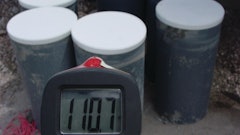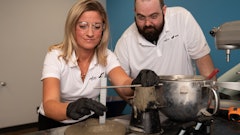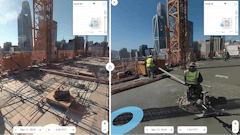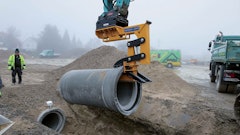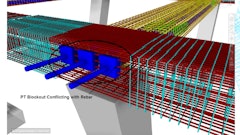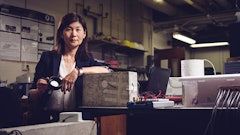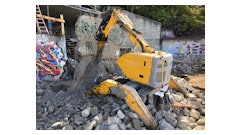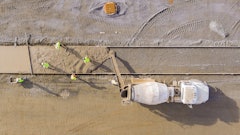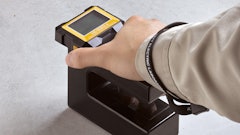
The concept and practice of the Internet of Things (IoT) has been around for a while, but the impact in the modern concrete construction site has only broken the surface. Project managers and foremen alike have found benefits from IoT with apps providing intuitive solutions that range from inventory management, change documentation, office forms, and more.
Also benefiting from IoT on the jobsite are environmental technologies providing construction professionals with smart, actionable data. These solutions are capable of capturing data on the outside weather, report on interior air quality for jobsite safety, and embedded sensors in concrete that can survive long enough to transmit curing temperatures. One less noticed, yet vital, area also benefiting from sensor technology: the monitoring of concrete cylinders and core samples.  MultiTech | Red Wireless | Haengel & Associates Engineering Inc.
MultiTech | Red Wireless | Haengel & Associates Engineering Inc.
Haengel & Associates Engineering Inc. (HAE), a consulting engineering firm working with the Great Lakes building community, monitors and maintains strict temperature levels within their lab’s specialized pH solution tanks. Providing evaluation services for advanced materials from product development to materials already in place, the company also helps to diagnose failures, develop methods for improving existing products as well as recommends new users for materials for different applications.
Monitoring the water in these tanks allows contractors to better understand how that concrete would react to real-world road/construction conditions. However, keeping this environment accurate to mimic and speed up these effects comes with its own set of challenges and HAE needed a method to capture accurate data from its tanks. Michigan-based Red Wireless proposed a solution.
While one can use a pen and paper to record results, today’s sensors provide a lot more efficiency and capabilities with automation and event-driven actions such as temperature thresholds and SMS alarms can be set without constant attention. With a single sensor per tank, the probe is able to withstand the higher-than-normal alkaline levels and connect them to an IoT remote monitoring solution.
Keeping the integrity of the concrete core samples is critical and careful inspections and methodical measurements must be accurately logged hourly, daily, and weekly. With each concrete sample costing from $1,000 to $3,000 per, each tank held 20 or more cylinders – it was vital the environment held true, and data collected were accurate.
More on Concrete Core Cylinders, Monitoring & Drilling from ForConstructionPros.com
7 Methods for Testing Concrete Strength - There are many different practices aside from cylinder break tests that can be used.
5 Concrete Core Drilling Tips - A few tips for concrete core drill selection and best practices for contractors who are drilling holes in concrete.
The Next Generation of Concrete Core Drills Will Bring Next Gen Safety Technology - The ever-changing field of power tool safety technology addresses one of the most dreaded: concrete core drilling.
Wireless Concrete Monitoring: Embedded vs. Non-embedded Bluetooth Transmitters - Maturity testing addresses the guesswork and can prove if on-site concrete has achieved required strength and whether or not formwork removal and load application is feasible.
The monitoring process required the tracking of data, every hour daily for 12 months. The sensor and wireless connectivity technology needed to handle this heavy load and contain a battery that could withstand this demand. The solution also had to withstand the harshest of RF environments, with minimal or no human intervention after installation.
Further complicating the process, the project was deployed at the start of the COVID-19 pandemic. With lock-down guidelines, the supervision and manual recording of the concrete cylinders' water environment would be challenging.  The MultiTech Conduit AP Access Point. LoRa works by collecting data from rugged sensors and sending vital information via a gateway to the network and the connected platform. This allows the software to monitor the environment and create status alerts and reports.MultiTech
The MultiTech Conduit AP Access Point. LoRa works by collecting data from rugged sensors and sending vital information via a gateway to the network and the connected platform. This allows the software to monitor the environment and create status alerts and reports.MultiTech
Allowing for remote observation and data collection, Red Wireless opted for LoRaWAN protocol for its wireless communication and MultiTech’s Reveal industrial LoRaWAN wireless sensors. The HAE lab included unrelated chemical, environmental and geotechnical experiments and applications, causing ambient noise and interference. This protocol was designed to be robust against such “noisy” RF environments and is also secure and encrypted and the sensors were compatible with the necessary network architecture.
The MultiTech Reveal sensors are designed with an open architecture for flexible integration, and an optional web-based console for provisioning, monitoring, and configuration of the sensors in the field. A custom design is also available with the goal of achieving seamless sensor-to-cloud solutions for a variety of applications. Due to its rugged yet small form factor, the MultiTech Conduit AP Access Point for LoRa technology was selected. This allowed HAE to be able to extend LoRa connectivity inside.
The pilot began March 16, 2020 - one week before the state’s COVID stay-at-home order began for non-essential workers. Yet, an automated, real-time dashboard and weekly emailed reports allowed HAE to ensure the accuracy of the concrete cylinder testing environment.  The MultiTech Reveal industrial LoRaWAN wireless sensors and MultiTech Conduit AP were utilized to measure temperatures in specialized pH tanks in rugged environments.MultiTech
The MultiTech Reveal industrial LoRaWAN wireless sensors and MultiTech Conduit AP were utilized to measure temperatures in specialized pH tanks in rugged environments.MultiTech
Using the MultiTech sensors and Red Wireless connectivity, HAE were able to capture 8,760 temperature data points in a year – not including the periodic, supervisory, and other non-temperature related messages.
In a case study published in June 2021 by Red Wireless, Gus Haengel, president of HAE, expressed how invaluable it was to receive the automated reports of a one-page summary weekly overview and multiple-page detailed log of hourly data points. The data allowed him a quick and effective analysis and the ability to easily share the data and to have an outlook on trends for the week ahead.
Ultimately, the project was a success with exceeded expectations, says José Cruz, CEO of Red Wireless. The company has over 25 years of cellular and non-cellular wireless experience, connectivity is at the very core of all Red Wireless operations and forms the foundation for all our services. “The success of this solution was a result of the excellent partners,” says Cruz. “I am happy to report that HAE Associates rated us with a 100% satisfaction rating.”
The list is long for Red Wireless in terms of future plans, but for starters, it includes new sensors with specialized probes to monitor the water levels of the specific pH-solution-filled tanks, as well as other indoor and outdoor building metrics. One thing is true for Cruz, “our plans and list for the future is long, but MultiTech’s Reveal sensors is clearly one of the stars.”






